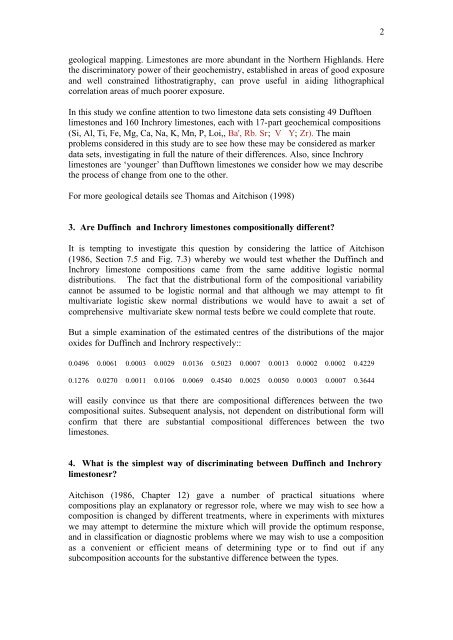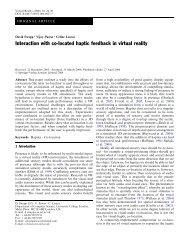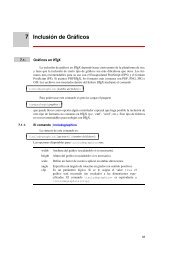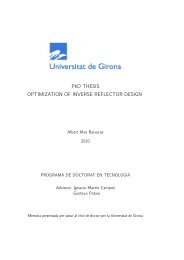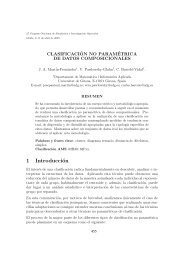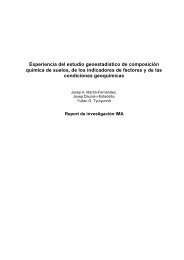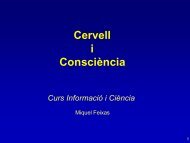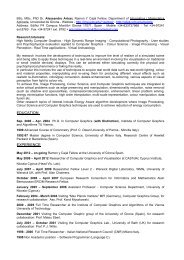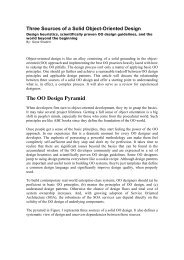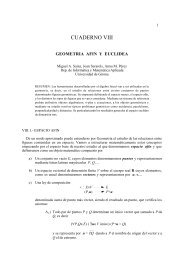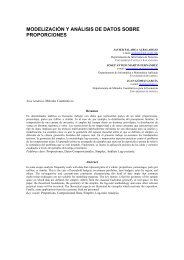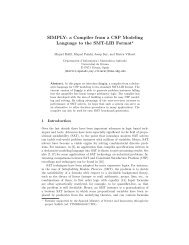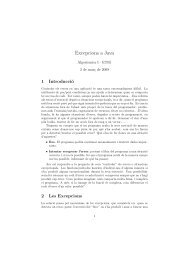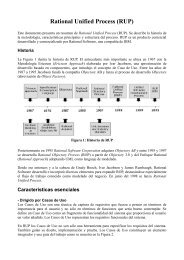2geological mapping. Limestones are more abundant in the Northern Highl<strong>and</strong>s. Herethe discriminatory power of their geochemistry, established in areas of good exposure<strong>and</strong> well constrained lithostratigraphy, can prove useful in aiding lithographicalcorrelation areas of much poorer exposure.In this study we confine attention to two limestone data sets consisting 49 Dufftoenlimestones <strong>and</strong> 160 Inchrory limestones, each with 17-part geochemical compositions(Si, Al, Ti, Fe, Mg, Ca, Na, K, Mn, P, Loi,, Ba', Rb. Sr; V Y; Zr). The mainproblems considered in this study are to see how these may be considered as markerdata sets, investigating in full the nature of their differences. Also, since Inchrorylimestones are ‘younger’ than Dufftown limestones we consider how we may describethe process of change from one to the other.For more geological details see <strong>Thomas</strong> <strong>and</strong> <strong>Aitchison</strong> (1998)3. Are Duffinch <strong>and</strong> Inchrory limestones compositionally different?It is tempting to investigate this question by considering the lattice of <strong>Aitchison</strong>(1986, Section 7.5 <strong>and</strong> Fig. 7.3) whereby we would test whether the Duffinch <strong>and</strong>Inchrory limestone compositions came from the same additive logistic normaldistributions. The fact that the distributional form of the compositional variabilitycannot be assumed to be logistic normal <strong>and</strong> that although we may attempt to fitmultivariate logistic skew normal distributions we would have to await a set ofcomprehensive multivariate skew normal tests before we could complete that route.But a simple examination of the estimated centres of the distributions of the majoroxides for Duffinch <strong>and</strong> Inchrory respectively::0.0496 0.0061 0.0003 0.0029 0.0136 0.5023 0.0007 0.0013 0.0002 0.0002 0.42290.1276 0.0270 0.0011 0.0106 0.0069 0.4540 0.0025 0.0050 0.0003 0.0007 0.3644will easily convince us that there are compositional differences between the twocompositional suites. Subsequent analysis, not dependent on distributional form willconfirm that there are substantial compositional differences between the twolimestones.4. What is the simplest way of discriminating between Duffinch <strong>and</strong> Inchrorylimestonesr?<strong>Aitchison</strong> (1986, Chapter 12) gave a number of practical situations wherecompositions play an explanatory or regressor role, where we may wish to see how acomposition is changed by different treatments, where in experiments with mixtureswe may attempt to determine the mixture which will provide the optimum response,<strong>and</strong> in classification or diagnostic problems where we may wish to use a compositionas a convenient or efficient means of determining type or to find out if anysubcomposition accounts for the substantive difference between the types.
3Binary logistic discrimination. For two types, such as the Duffinch <strong>and</strong> Inchrorylimestones here we may use binary logistic regression with logconstrasts of thecompositional components as the regressor; for a D-part composition x a logcontrastis defined aslc( α, x) = α log x1 + .. . + αDlog xD( α1 + .. . + αD= 0 ) .For two types (t = 0, t = 1) the binary logistic model is thus defined byexp{ α0+ lc( α , x)}pr( t = 0 | x) = 1 − pr( t = 1 | x)=1 + exp{ α + lc( α , x)}0.Maximum likelihood estimation of the parameter α is straightforward. The beauty ofthis model is that the adequacy of a subcomposition say (1, . . . , C) can readily betested since this hypothesis can be expressed as αC+ 1= . . . = αD= 0 . Thus the wholelattice of subcompositional hypotheses can be investigated <strong>and</strong> any adequatesubcomposition identified. Examples of this procedure can be found for hongitekongitediscrimination <strong>and</strong> Permian <strong>and</strong> post-Permian: discrimination in <strong>Aitchison</strong>(1986, Sections 12.6, 12.7).Figure 1 shows a portion of the substantial lattice of subcompositional hypotheseswith some of the more interesting subcompositions highlighted. The maximum modelat the top of the lattice retains the full 17-part composition as the explanatory variable.At the foot of the lattice is the hypothesis that compositional information is useless.At the next bottom level we have all the two-part subcompositions; at the next levelall the three-part subcompositions, <strong>and</strong> so on. In such lattice testing we usegeneralised likelihood ratio tests always testing the hypothesis within the maximummodel, starting with the simplest hypothesis, moving up the lattice to the next levelonly if we can reject all the hypotheses at the lower level <strong>and</strong> so on until we reach ahypothesis that we cannot reject. In the event that there are several non-rejectablehypotheses at a particular level that we either ‘accept’ the one with the smallestlikelihood ratio or move to the next level <strong>and</strong> ‘accept’ the hypothesis with the smallestlikelihood ratio. It should be remembered that in the absence of any loss structure in amultiple hypothesis situation all testing procedures are essentially ad hoc. We canonly report that we have found that this form of lattice testing usually leads to sensibleinferences.The dramatic result for limestones was reported in <strong>Thomas</strong> <strong>and</strong> <strong>Aitchison</strong> (1998),where out of the 17-part geochemical composition a 3-part subcomposition, namely(Fe, Mg, Ca), is found to be an adequate discriminator. The separation of the duffinch<strong>and</strong> inchrory limestones on the basis of the (Fe, Mg, Ca) subcomposition wasillustrated in a logratio scattergram, namely a (log(Fe/Ca), log(Mg/Ca)) plot. Weshow in Figure 2a the ternary diagram of the (Fe, Mg, Ca) subcompositions. Becauseof the smallness of Fe <strong>and</strong> Mg relative to Ca the subcompositional points crowd intothe Ca corner of the ternary diagram providing little illumination of the differences inthe duffinch <strong>and</strong> inchrory subcompositions. We can, however, use the device of acentering perturbation *von Eynatten, Pawlowsky-Glahn <strong>and</strong> Mateu Figueras, 2002)to provide a clearer picture of the separation. This is shown in Figure 2b, together


